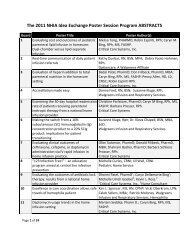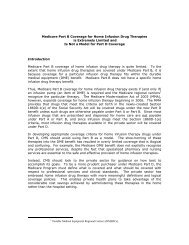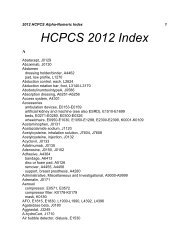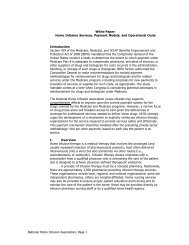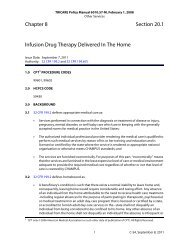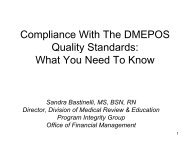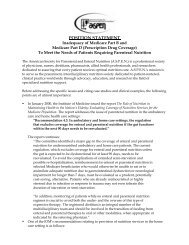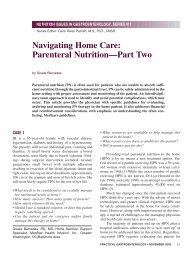Kaiser Family Foundation Survey on State Medicaid Managed Care ...
Kaiser Family Foundation Survey on State Medicaid Managed Care ...
Kaiser Family Foundation Survey on State Medicaid Managed Care ...
- No tags were found...
You also want an ePaper? Increase the reach of your titles
YUMPU automatically turns print PDFs into web optimized ePapers that Google loves.
In some states, reducing avoidable ER use in <strong>Medicaid</strong> is part of a state-wide effort that may also involveother payers, statewide educati<strong>on</strong> efforts, establishment of nurse advice lines, and collaborati<strong>on</strong> am<strong>on</strong>ghospitals, health plans, and primary care providers. These initiatives often include the development ofdiversi<strong>on</strong> protocols that redirect people with n<strong>on</strong>-emergent needs to appropriate sites for care, such asa nearby clinic or their primary care provider. Some ER-related efforts are part of a chr<strong>on</strong>ic caremanagement initiative that focuses <strong>on</strong> individuals with specific diseases, such as asthma, diabetes,hypertensi<strong>on</strong>, or c<strong>on</strong>gestive heart failure. <strong>State</strong> medical home initiatives also include a focus <strong>on</strong> reducinginappropriate ER use and ensuring that care is provided in the appropriate setting. Most states areevaluating the effectiveness of their efforts to reduce ER use. Some states, but not all, reported reducedER use resulting from state initiatives.Most states report initiatives to address obesity, with <strong>Medicaid</strong> MCOs often playing a leading role.<strong>State</strong> <strong>Medicaid</strong> programs have a large stake in efforts to reduce obesity because many <strong>Medicaid</strong>beneficiaries suffer from chr<strong>on</strong>ic c<strong>on</strong>diti<strong>on</strong>s related to obesity, such as diabetes. Initiatives to m<strong>on</strong>itorand reduce obesity were reported by 34 states, with <strong>Medicaid</strong> MCOs often playing a key role. Toillustrate, in Michigan, all <strong>Medicaid</strong> MCOs are required to c<strong>on</strong>duct a performance improvement project(PIP) <strong>on</strong> childhood obesity, which must be evaluated by the EQRO. California and Tennessee require<strong>Medicaid</strong> MCOs to report scores annually for the HEDIS© measure “Weight Assessment & Counselingfor Nutriti<strong>on</strong> & Physical Activity for Children and Adolescents,” and other states have added otherHEDIS© measures relating to BMI. In some cases, MCOs have developed their own weight-reducti<strong>on</strong> ordisease management programs for obese adult and child enrollees. A number of <strong>Medicaid</strong> programs areparticipating in state-wide obesity initiatives that involve surveys, data collecti<strong>on</strong>, educati<strong>on</strong>, and healthpromoti<strong>on</strong>.All Tenn<strong>Care</strong> MCOs have implemented a disease management (DM) obesity program for children and adults withparticipants identified through self-referral, physician referral, and community referrals, and through other DMand care management (CM) program engagement, such as health risk assessments. Risk stratificati<strong>on</strong>, typicallybased <strong>on</strong> Body Mass Index and/or co-occurring c<strong>on</strong>diti<strong>on</strong>s, determines the type and intensity of interventi<strong>on</strong>s,which can include educati<strong>on</strong>al material addressing nutriti<strong>on</strong>, exercise and weight management, referrals tocommunity partners that supply weight management programs, and individual care plans addressing weight loss.The DM obesity programs are evaluated annually based <strong>on</strong> both process and outcome measures.About half the states report initiatives in <strong>Medicaid</strong> to address racial and ethnic disparities, includingparticipati<strong>on</strong> in broader state efforts. Because of <strong>Medicaid</strong>’s large role in paying for births and coveringcommunities of color, the program is instrumental to efforts to narrow racial and ethnic disparities inaccess, care, and outcomes related to major chr<strong>on</strong>ic diseases. Federal regulati<strong>on</strong>s require states toprovide their c<strong>on</strong>tracted MCOs with data <strong>on</strong> the race and ethnicity of their <strong>Medicaid</strong> enrollees to allowhealth plans to measure, m<strong>on</strong>itor, and address disparities.Just under half of state <strong>Medicaid</strong> programs (24 states) reported that they had or would have qualityinitiatives in <strong>Medicaid</strong> specifically to address racial and ethnic disparities. Numerous states reportedformal <strong>Medicaid</strong> PIPs focused <strong>on</strong> reducing racial and ethnic disparities in certain measures (e.g.,adolescents’ use of well-child visits, breast or cervical cancer screening rates), or <strong>on</strong> culturalcompetency. In <strong>on</strong>e state, each MCO has a “disparity committee” that analyzes data by race andethnicity and recommends interventi<strong>on</strong>s for the plan to implement. Several states analyze quality databy race and ethnicity, including <strong>on</strong>e state that publishes the data. A number of states reported broader40 00



